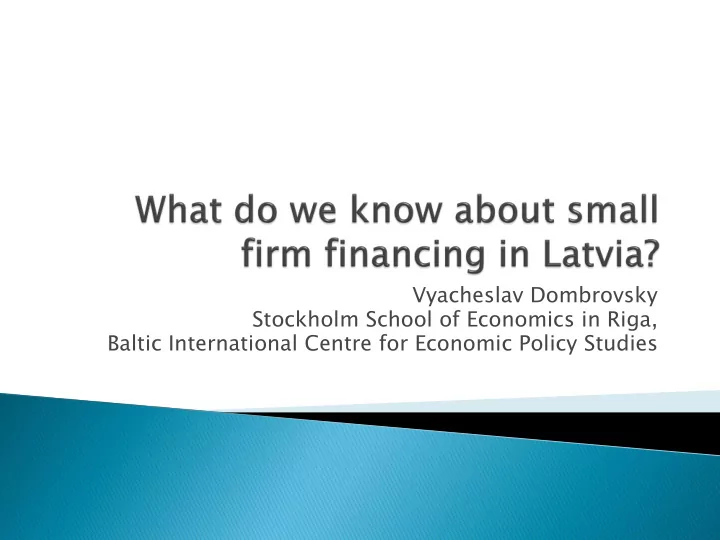

Vyacheslav Dombrovsky Stockholm School of Economics in Riga, Baltic International Centre for Economic Policy Studies
Overview of our research program at SSE- Riga, TeliaSonera Institute, and BICEPS ◦ Global Entrepreneurship Monitor (GEM) ◦ Panel Study of Entrepreneurial Dynamics (PSED) ◦ Survey of Innovative Businesses in Latvia (SIBiL) Suggestions for building a research program in Estonia Discussion…
Research programme that aims to assess • entrepreneurial activity across countries and over time 42 countries participated in the 2007 exercise • Common methodology, basically a (CATI) • survey of about 2,000 adults in each country Latvia is the only Baltic state in the GEM • consortium We‟ve conducted GEM surveys since 2005 •
GEM generates reasonable publicity and is relatively good to gauge the overall situation with entrepreneurship, especially with nascent entrepreneurs However, (cheaper) competing indicators begin appearing (World Bank, OECD, European Commission) Also badly suited for analysis of entrepreneurs because of small sample sizes Collection of the data procedures could have been more rigorous…
Panel Study of Entrepreneurial Dynamics (PSED) originated in the U.S. in 1990s The aim is to study nascent entrepreneurs , i.e. those who are at the earliest stage of business creation The survey is expensive because of the need to identify a sufficient and representative group of nascents (only about 4% of adult population in Latvia) Latvian PSED covers 400 nascent entrepreneurs, to date two rounds have been conducted (longitudinal data)
Business start-up process Market and competition Owners and financing (Section D) Future expectations and motivation Attitudes Knowledge of the tax system Demographic information
49% of all nascents fund their start-up entirely by their own savings 4% received a loan from family members 1.25% received an asset-backed loan 39% refused to disclose their source of financing
Geared to understanding the process of creation of new ventures Sample sizes are typically insufficient for the analysis of the more innovative and hi-tech businesses
Community Innovation Survey (CIS) and its problems ◦ reliability of the survey instrument (mailed questionnaires) ◦ Only covers firms with >10 employees ◦ A relatively short survey From CIS to SIBiL ◦ Focus on micro (<10) and small (10-49) firms, especially in hi-tech sectors ◦ Face-to-face interviews (N=1,271) ◦ Panel aspect (two waves) ◦ Full control of the survey design and implementation (using Lursoft)
Innovation section (adapted from CIS) 1. product or process innovations, ongoing or abandoned, ◦ cooperation, intellectual property, etc. Financing section (adapted from the Fed‟s Survey of Small 2. Business Finance) loan applications, successful or not, reasons for unsuccessful ◦ Competitive strategy 3. Background of three largest owners 4. gender, ethnicity, education (level and field), previous work ◦ experience Balance sheets for 1996-2007 (Lursoft) 5. Profit and loss accounts for 1996-2007 (Lursoft) 6. Ownership variables for 2007 (Lursoft) 7. foreign owners, country of origin, ownership concentration ◦
A striking aspect of SIBiL is that it shows that a very high proportion of firms with product innovations (55% in manufacturing) as compared with „official‟ CIS (about 20%) One paper tries to find empirical evidence on the theory of „symbiosis‟ between large and small firms; it looks at the background of owners The second paper attempts to address the question whether there is learning from exporting, using owners ethnicity as an instrument
did you apply once, more than once, or not at all for new loans? Freq. Percent Cum. once 176 13.85 13.85 more than once 208 16.37 30.21 not at all 874 68.76 98.98 don't know/ na 13 1.02 100.00 Total 1,271 100.00
applications always approved? Freq. Percent Cum. always approved 149 71.63 71.63 always denied 15 7.21 78.85 sometimes approved, sometimes denied 35 16.83 95.67 don't know/ na 9 4.33 100.00 Total 208 100.00 denied? Freq. Percent Cum. approved 153 72.51 72.51 denied 28 13.27 85.78 don't know/ na 30 14.22 100.00 Total 211 100.00
for the most recent denial, what type of credit was applied for? Freq. Percent Cum. new line of credit 2 4.55 4.55 capital lease 8 18.18 22.73 equipment loan 18 40.91 63.64 loan for real estate acquisition for pr 5 11.36 75.00 vehicles lease 1 2.27 77.27 industrial lease 1 2.27 79.55 some other type of loan (please specify 5 11.36 90.91 increase in overdraft/credit line limit 1 2.27 93.18 don't know 3 6.82 100.00 Total 44 100.00 for this most recent denial, what was the total amount? Percentiles Smallest 1% 15 15 5% 3000 3000 10% 5000 5000 Obs 32 25% 11000 5000 Sum of Wgt. 32 50% 50000 Mean 204688 Largest Std. Dev. 388188.1 75% 200000 300000 90% 300000 1000000 Variance 1.51e+11 95% 1500000 1500000 Skewness 2.652207 99% 1500000 1500000 Kurtosis 8.875512
apply? Freq. Percent Cum. yes 173 13.61 13.61 no 1,078 84.82 98.43 don't know/ na 20 1.57 100.00 Total 1,271 100.00
Insufficient collateral or no guarantee available (18%) Poor balance sheet, financial situation (6.4%) Loan too large (5%) Firm too small for institution (6%) Firm too highly leveraged (7%)
You need to be careful in talking about “financing gap” e.g. is there a „Mercedes gap‟? Typically, most businesses get started with owners‟ savings or family loans This is not a bad thing as it gives future potential investors a signal about the entrepreneurs However, the distribution of incomes may not coincide with the distribution of ideas Even though there should be substantial correlation Also, is there an “equity gap”?
How to contract research? Permanent basis vs. occasionally Preferred researches vs tenders How to monitor quality? Think about designing program evaluation studies ◦ treatment group vs control group
Recommend
More recommend